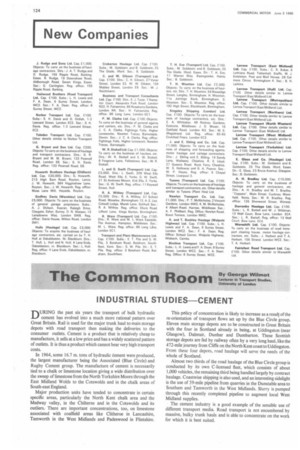INDUSTRIAL STUDIES CEMENT
Page 126

If you've noticed an error in this article please click here to report it so we can fix it.
DURING the past six years the transport of bulk hydraulic cement has evolved into a much more rational pattern over Great Britain. Rail is used for the major trunk haul to main storage depots with road transport then making the deliveries to the consumer outlets. Cement is a product that is relatively cheap to manufacture, it sells at a low price and has a widely scattered pattern of outlets. It is thus a product which cannot bear very high transport costs.
In 1964, some 16.7 m. tons of hydraulic dement were produced, the largest manufacturer being the Associated (Blue Circle) and Rugby Cement group. The manufacture of cement is necessarily tied to a chalk or limestone location giving a wide distribution over the sweep of limestone from the North Yorkshire Moors through the East Midland Wolds to the Cotswolds and in the chalk areas of South-east England.
Major production units have tended to concentrate in certain specific areas, particularly the North Kent chalk area and the Medway valley, in the Chilterns and in the Cotswolds and its outliers. There are important concentrations, too, on limestone associated with coalfield areas like Clitheroe in Lancashire, Tamworth in the West Midlands and Padeswood in Flintshire. This policy of concentration is likely to increase as a result of the re-orientation of transport flows set up by the Blue Circle group. Eleven main storage depots are to be constructed in Great Britain with the four in Scotland already in being, at Uddingston (near Glasgow), Dalmuir, Dunbar and Dumbarton. These Scottish storage depots are fed by railway often by a very long haul, like the 472-mile journey from Cliffe on the North Kent coast to Uddingston. From these four depots, road haulage will serve the needs of the whole of Scotland.
Almost two thirds of the road haulage of the Blue Circle group is conducted by its own C-licensed fleet, which consists of about 1,000 vehicles, the remaining third being handled largely by contract haulage. Coastwise shipping is also used, and an interesting sidelight is the use of 59-mile pipeline from quarries in the Dunstable area to Southam and Tamworth in the West Midlands. Slurry is pumped through this recently completed pipeline to augment local West Midland supplies.
The cement industry is a good example of the sensible use of different transport media. Road transport is not encumbered by massive, bulky trunk hauls and is able to concentrate on the work for which it is best suited.








































































































































































